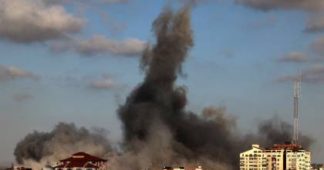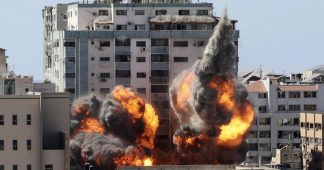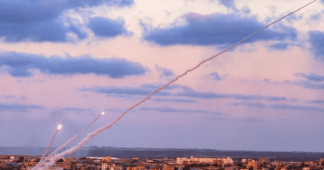A break in hostilities could benefit Israel militarily, even though it could hurt Prime Minister Netanyahu politically.
By Published On 21 Nov 2023
Claims and denials of a potential ceasefire in Gaza continue. Some reports refer to a three-day pause in fighting, while others extend the truce to a full five days. Still, others claim the ceasefire could begin imminently. And so on.
Even statements from the horse’s mouth differ. Israeli Prime Minister Benjamin Netanyahu denied the report published by The Washington Post on Saturday that a tentative deal had been reached; a United States representative confirmed that talks were continuing but that a breakthrough was still awaited.
On Sunday, Qatar’s Prime Minister Sheikh Mohammed bin Abdulrahman Al Thani announced in Doha that the differences remaining between Hamas and Israel were “very minor”. Qatar has been central to mediation efforts in the war, including for the release of Israeli captives.
The last to be heard on the subject was Hamas leader Ismail Haniyeh who on Tuesday told Reuters news agency that the parties are “close to reaching a truce agreement”. Another Hamas official told Al Jazeera that negotiations were centred on the duration of the truce, details of aid delivery to Gaza and the exchange of hostages and prisoners.
Where there’s smoke, there’s fire. With most parties involved looking to temporarily halt the carnage in Gaza, one must hope for the small step to a temporary respite.
It is also prudent to examine why the two warring sides are considering such a hiatus.
While such a pause would benefit Hamas politically, militarily there seems to be no obvious gain — as I’ll explain on Wednesday.
For Israel, on the other hand, pausing the war could be advantageous from a military point of view and disadvantageous from a political one.
The Israeli war machine has been going at full strength for six weeks in the air and three weeks on the ground in Gaza. Since the Hamas attacks, Israel’s aerial bombardment has continued at a surprisingly high rate.
It was clear from day one that the primary purpose of such merciless pounding of Palestinian civilian targets was not military. Initially, many analysts believed that the intense aerial attacks served to demonstrate to the Israeli populace that the armed forces were doing something and that bombing would be eased once land forces moved in.
Even a country that boasts of its preparedness for war needs to maintain substantial reserves of weapons and ammunition.
Omar Bradley, a US Army general during World War II, once said “amateurs talk strategy, professionals talk logistics”. Israeli forward commanders may be eager to continue pounding Gaza come what may, but the rear echelon has done the maths and does not like the result. There are reliable reports escaping the net of military secrecy that the Israeli Air Force (IAF) is running out of smart bombs.
It is always difficult to judge the credibility of allegations in military matters. Sometimes an officer who is disillusioned with his side — especially when it is fighting outside its borders or inflicting heavy civilian losses — will anonymously leak crucial details.
Several specialised online forums claim that the IAF, having expended more than 2,500 joint direct attack munition (JDAM) smart bomb kits over Gaza, has just 10 days of stocks remaining.
Every military regulates how much ammunition must remain in reserve for emergencies. Exact figures are a guarded secret, but everything points to Israel’s quartermasters having sounded alarms, asking for urgent replenishment.
Specialised military items can be bought to fill gaps. In 1973, when Israel was on the verge of running out of stocks fighting Syria, Egypt and their Arab allies, the US launched “Operation Nickel Grass”, the biggest military airlift in history. The US Air Force flew almost 1,000 tonnes of weapons and ammunition to Israel per day, for a total of more than 22,000 tonnes.
That is being repeated now, albeit on a smaller scale. For the past two weeks, US C-17 transports have been landing regularly at Ben Gurion airport in Tel Aviv and at Nevatim airbase in the Negev desert.
Most aircraft fly in from the Ramstein airbase in Germany, where the US has warehouses full of “prepositioned stock” — equipment set aside for military emergencies.
There is little doubt that heavier and less urgent supplies are being shipped to Israel by sea. Among them will surely be replenishment rockets for the tracked version of the high mobility artillery rocket systems (HIMARS), the M270 multiple-launch rocket system (MLRS) that saw heavy use in Gaza.
In October, the US released its own missiles for the Iron Dome air defence system to Israel. Israel’s response to initial heavy Hamas rocket attacks and attacks from Hezbollah and the Houthis had depleted Israel’s stocks to such an alarming level that it requested all of the Tamir interceptor missiles that the US had bought and kept in Israel until deployment.
The Israeli forces would also welcome a break in fighting to evaluate its tactics so far in light of its performance against Hamas tunnels. As many analysts have warned — me included — despite dogs, robots, ground-penetrating radars, and other technology, the tunnels can be destroyed only once soldiers get inside. That is a bloody task, as was proven last week when four commandos were killed by an improvised explosive device after opening a tunnel cover.
A few days ago, an unidentified Israeli officer briefing reporters embedded with the Israeli forces admitted, “We don’t want to go down there. We know that they left us a lot of side bombs.” London-based weekly The Jewish Chronicle reported on November 16 that standing orders were clear: “No one is allowed to go into a tunnel.”
The Israeli forces must also look into the effectiveness of their allegedly sophisticated and specialised training in simulators of Gaza City. Some of the simulation assumptions based on 2009 and 2014 incursions into Gaza have proven not applicable in 2023. It will also have to analyse why so many Merkava tanks, believed almost invincible, were incapacitated. Reliable reports indicate up to 30 have been destroyed or are too damaged to use.
While the military would welcome three or five days of respite — but would likely not admit it — politicians would clearly see it as their loss.
Netanyahu and his hawks have been staunchly against any pause so if they accept it now, the public will see it as their weakness, no matter how they try to justify bowing to international pressure. The fact that US President Joe Biden, notionally Israel’s closest ally, has put his weight behind securing a break must be rubbing salt into the Israeli PM’s wounds.
If the agreed period without fighting is observed, which is always a big risk, Israeli politicians will face new pressure at its end; the world might ask, “If it was a success, why don’t you just extend it?”
Netanyahu’s greatest nightmare would be to get to a point where he not only failed to destroy Hamas but de facto recognised it by negotiating, even if indirectly. Deprived of Gaza, fuming Israelis would certainly go for his political skin instead.
We remind our readers that publication of articles on our site does not mean that we agree with what is written. Our policy is to publish anything which we consider of interest, so as to assist our readers in forming their opinions. Sometimes we even publish articles with which we totally disagree, since we believe it is important for our readers to be informed on as wide a spectrum of views as possible.











